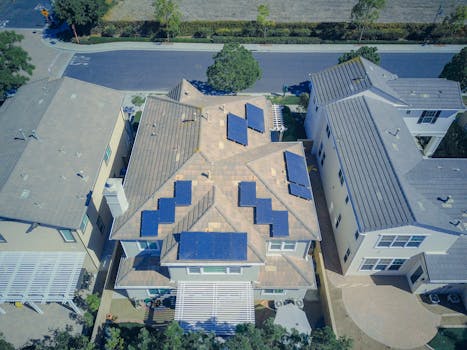“Maximize Efficiency: Choose the Right Solar Inverter for Optimal Performance!”
Maximizing efficiency in solar energy systems is crucial for optimizing performance and ensuring a good return on investment. Selecting the right solar inverter plays a pivotal role in this process, as it converts the direct current (DC) generated by solar panels into alternating current (AC) for use in homes and businesses. With various types of inverters available, including string inverters, microinverters, and power optimizers, understanding their features, efficiency ratings, and compatibility with your solar setup is essential. This guide provides valuable tips for choosing the best solar inverter, helping you enhance the overall efficiency of your solar energy system and achieve sustainable energy goals.
Understanding Solar Inverter Types
When it comes to harnessing solar energy, the solar inverter plays a pivotal role in maximizing efficiency and ensuring optimal performance of a solar power system. Understanding the different types of solar inverters available on the market is essential for making an informed decision that aligns with your energy needs and budget. The three primary types of solar inverters are string inverters, microinverters, and power optimizers, each offering distinct advantages and disadvantages.
String inverters are the most commonly used type of solar inverter, particularly in residential installations. They work by connecting a series of solar panels, or strings, to a single inverter. This configuration simplifies the installation process and reduces costs, making string inverters an attractive option for many homeowners. However, one of the main drawbacks of string inverters is their susceptibility to shading issues. If one panel in a string is shaded or underperforming, it can affect the entire string’s output. Therefore, while string inverters are efficient in ideal conditions, their performance can be compromised in less-than-ideal scenarios.
In contrast, microinverters offer a more advanced solution by attaching a small inverter to each individual solar panel. This design allows each panel to operate independently, which means that shading or performance issues with one panel do not impact the others. As a result, microinverters can significantly enhance the overall energy production of a solar system, particularly in installations where shading is a concern. Additionally, microinverters often come with monitoring capabilities, allowing homeowners to track the performance of each panel in real-time. However, this increased efficiency and monitoring capability comes at a higher upfront cost, which may be a consideration for budget-conscious consumers.
Power optimizers represent a hybrid solution that combines elements of both string inverters and microinverters. These devices are installed on each solar panel and work to maximize the energy output of each panel while still connecting to a central string inverter. This configuration allows for improved performance in shaded conditions, similar to microinverters, while maintaining a more cost-effective installation process. Power optimizers can be an excellent choice for homeowners looking to balance performance and budget, as they provide many of the benefits of microinverters without the same level of investment.
As you consider which type of solar inverter is best for your needs, it is also important to evaluate factors such as system size, installation location, and future energy requirements. For instance, if you live in an area with frequent shading or plan to expand your solar system in the future, investing in microinverters or power optimizers may be more beneficial in the long run. On the other hand, if your roof receives ample sunlight and you are looking for a cost-effective solution, a string inverter may suffice.
Ultimately, selecting the right solar inverter is crucial for maximizing the efficiency of your solar energy system. By understanding the differences between string inverters, microinverters, and power optimizers, you can make a more informed decision that aligns with your specific energy needs and financial considerations. As the solar industry continues to evolve, staying informed about the latest technologies and trends will empower you to make choices that enhance the performance and longevity of your solar investment.
Key Features to Look for in Solar Inverters
When considering the installation of a solar energy system, one of the most critical components to evaluate is the solar inverter. This device plays a pivotal role in converting the direct current (DC) generated by solar panels into alternating current (AC), which is the form of electricity used in homes and businesses. To maximize efficiency and ensure a reliable energy supply, it is essential to understand the key features to look for in solar inverters.
First and foremost, the efficiency rating of a solar inverter is paramount. This rating indicates how well the inverter converts DC electricity into AC electricity. A higher efficiency rating means less energy is lost during the conversion process, which translates to more usable power for your home. Inverters typically have efficiency ratings ranging from 90% to over 98%. Therefore, selecting an inverter with a high efficiency rating can significantly impact the overall performance of your solar energy system.
Another important feature to consider is the inverter’s power output capacity, often measured in kilowatts (kW). This capacity should align with the size of your solar panel system and your energy consumption needs. If the inverter’s capacity is too low, it may not be able to handle the energy produced by the solar panels, leading to potential energy loss. Conversely, an inverter with excessive capacity may be more expensive and unnecessary for your specific requirements. Therefore, it is crucial to conduct a thorough assessment of your energy needs and choose an inverter that matches your system’s output.
In addition to efficiency and power output, the type of inverter is also a significant factor. There are three main types of solar inverters: string inverters, microinverters, and power optimizers. String inverters are the most common and are suitable for systems with uniform shading and orientation. Microinverters, on the other hand, are installed on each solar panel, allowing for independent operation and maximizing energy production, especially in partially shaded conditions. Power optimizers combine features of both string inverters and microinverters, enhancing the performance of each panel while still using a central inverter. Understanding the advantages and disadvantages of each type will help you make an informed decision based on your specific installation conditions.
Furthermore, monitoring capabilities are an essential feature to consider when selecting a solar inverter. Many modern inverters come equipped with monitoring systems that allow users to track energy production and consumption in real-time. This feature not only provides valuable insights into the performance of your solar energy system but also helps identify any issues that may arise. By having access to this data, homeowners can take proactive measures to optimize their energy usage and ensure their system operates at peak efficiency.
Lastly, warranty and reliability should not be overlooked. A reputable solar inverter manufacturer will typically offer warranties ranging from five to twenty-five years, reflecting the durability and reliability of their products. A longer warranty period often indicates a higher level of confidence in the inverter’s performance and longevity. Therefore, it is advisable to choose an inverter from a well-established brand with a proven track record in the industry.
In conclusion, selecting the best solar inverter involves careful consideration of several key features, including efficiency rating, power output capacity, type of inverter, monitoring capabilities, and warranty. By prioritizing these factors, homeowners can maximize the efficiency of their solar energy systems, ensuring a sustainable and cost-effective energy solution for years to come.
Importance of Efficiency Ratings
When it comes to harnessing solar energy, the efficiency of the solar inverter plays a crucial role in determining the overall performance of a solar power system. The inverter is responsible for converting the direct current (DC) generated by solar panels into alternating current (AC), which is the form of electricity used in homes and businesses. Therefore, understanding the importance of efficiency ratings is essential for anyone looking to maximize the benefits of their solar investment.
Efficiency ratings indicate how well an inverter converts DC electricity into AC electricity. A higher efficiency rating means that more of the energy generated by the solar panels is utilized, resulting in greater energy output and, ultimately, cost savings. For instance, an inverter with an efficiency rating of 98% will convert 98% of the energy it receives from the solar panels into usable electricity, while a 90% efficient inverter will waste 10% of that energy. This difference can significantly impact the overall energy production of a solar system, especially over time.
Moreover, the efficiency of an inverter can vary based on several factors, including temperature, load conditions, and the specific design of the inverter itself. Therefore, it is essential to consider not only the peak efficiency rating but also the real-world performance of the inverter under various conditions. Many manufacturers provide performance data that reflects how their inverters perform in different scenarios, which can be invaluable when making a selection. By examining these performance curves, potential buyers can gain insights into how the inverter will function in their specific environment, ensuring that they choose a model that will deliver optimal results.
In addition to the direct impact on energy production, the efficiency of a solar inverter can also influence the longevity and reliability of the entire solar power system. Inverters that operate at higher efficiency levels tend to generate less heat, which can lead to reduced wear and tear on the components. This is particularly important because inverters are often considered the “weak link” in solar systems, with many requiring replacement after a certain number of years. By selecting a high-efficiency inverter, homeowners and businesses can not only enhance their energy output but also extend the lifespan of their solar investment.
Furthermore, it is essential to consider the implications of efficiency ratings on the overall return on investment (ROI) for a solar power system. A more efficient inverter can lead to higher energy production, which translates to lower electricity bills and a quicker payback period. In regions where electricity prices are high, the benefits of investing in a high-efficiency inverter become even more pronounced. Therefore, when evaluating different inverter options, it is crucial to weigh the initial costs against the potential long-term savings.
In conclusion, the importance of efficiency ratings in selecting a solar inverter cannot be overstated. Higher efficiency ratings lead to increased energy production, reduced heat generation, and improved ROI, making them a vital consideration for anyone looking to invest in solar energy. By understanding the nuances of inverter efficiency and how it affects overall system performance, consumers can make informed decisions that will maximize their solar investment and contribute to a more sustainable future. As the solar industry continues to evolve, staying informed about the latest advancements in inverter technology will empower individuals and businesses to harness the full potential of solar energy.
Comparing Costs vs. Performance
When it comes to selecting the best solar inverter for your solar energy system, understanding the balance between costs and performance is crucial. The inverter plays a pivotal role in converting the direct current (DC) generated by solar panels into alternating current (AC), which is used by most household appliances. Therefore, the choice of inverter can significantly impact both the efficiency of your solar energy system and your overall return on investment.
To begin with, it is essential to recognize that while the initial cost of an inverter is an important factor, it should not be the sole consideration. Cheaper inverters may seem appealing at first glance, but they often come with trade-offs in terms of performance, reliability, and longevity. For instance, lower-cost models may have lower efficiency ratings, which means they convert less of the solar energy into usable electricity. This inefficiency can lead to higher electricity bills over time, negating any initial savings. Therefore, it is wise to evaluate the efficiency ratings of various inverters, as a higher efficiency can lead to greater energy production and savings in the long run.
Moreover, the performance of an inverter is not solely determined by its efficiency rating. Factors such as the inverter’s ability to handle varying loads, its temperature tolerance, and its performance under different weather conditions also play a significant role. For example, some inverters are designed to perform better in high temperatures, which can be particularly beneficial in regions with hot climates. Additionally, inverters with advanced features, such as maximum power point tracking (MPPT), can optimize energy production by adjusting to changing sunlight conditions throughout the day. While these advanced features may come at a higher upfront cost, they can enhance the overall performance of your solar energy system, leading to increased energy savings over time.
Furthermore, it is important to consider the warranty and lifespan of the inverter when comparing costs and performance. A higher-quality inverter may come with a longer warranty period, which can provide peace of mind and protect your investment. Inverters typically have a lifespan of around 5 to 15 years, depending on the model and brand. Investing in a more expensive, high-performance inverter with a longer warranty can ultimately save you money by reducing the frequency of replacements and repairs.
In addition to evaluating individual inverter models, it is also beneficial to consider the overall system design. The compatibility of the inverter with your solar panels and other components can significantly influence performance. For instance, pairing high-efficiency solar panels with a lower-quality inverter may not yield the best results. Therefore, it is advisable to consult with a solar energy professional who can help you design a system that maximizes efficiency and performance while staying within your budget.
In conclusion, when comparing costs versus performance in selecting a solar inverter, it is essential to look beyond the initial price tag. By considering factors such as efficiency ratings, advanced features, warranty, and compatibility with your solar system, you can make a more informed decision that balances both cost and performance. Ultimately, investing in a high-quality inverter can lead to greater energy savings, improved system reliability, and a more sustainable energy future.
Q&A
1. **Question:** What is the primary function of a solar inverter?
**Answer:** The primary function of a solar inverter is to convert the direct current (DC) generated by solar panels into alternating current (AC) that can be used by home appliances and fed into the electrical grid.
2. **Question:** What efficiency rating should I look for in a solar inverter?
**Answer:** Look for a solar inverter with an efficiency rating of at least 95% to 98%, as higher efficiency means more of the solar energy is converted into usable electricity.
3. **Question:** How does the type of solar inverter affect system performance?
**Answer:** The type of solar inverter (string, micro, or power optimizer) affects system performance by influencing how energy is harvested from solar panels, with microinverters and power optimizers typically providing better performance in shaded or unevenly oriented installations.
4. **Question:** Why is warranty and reliability important when selecting a solar inverter?
**Answer:** Warranty and reliability are important because a longer warranty (typically 5 to 10 years) indicates manufacturer confidence in the product’s durability, and a reliable inverter minimizes downtime and maintenance costs over the system’s lifespan.
Conclusion
To maximize efficiency when selecting the best solar inverter, consider factors such as inverter type (string, micro, or central), efficiency ratings, compatibility with your solar panel system, monitoring capabilities, warranty and reliability, and installation requirements. Prioritizing these elements will ensure optimal energy conversion, enhance system performance, and ultimately lead to greater energy savings and return on investment.




